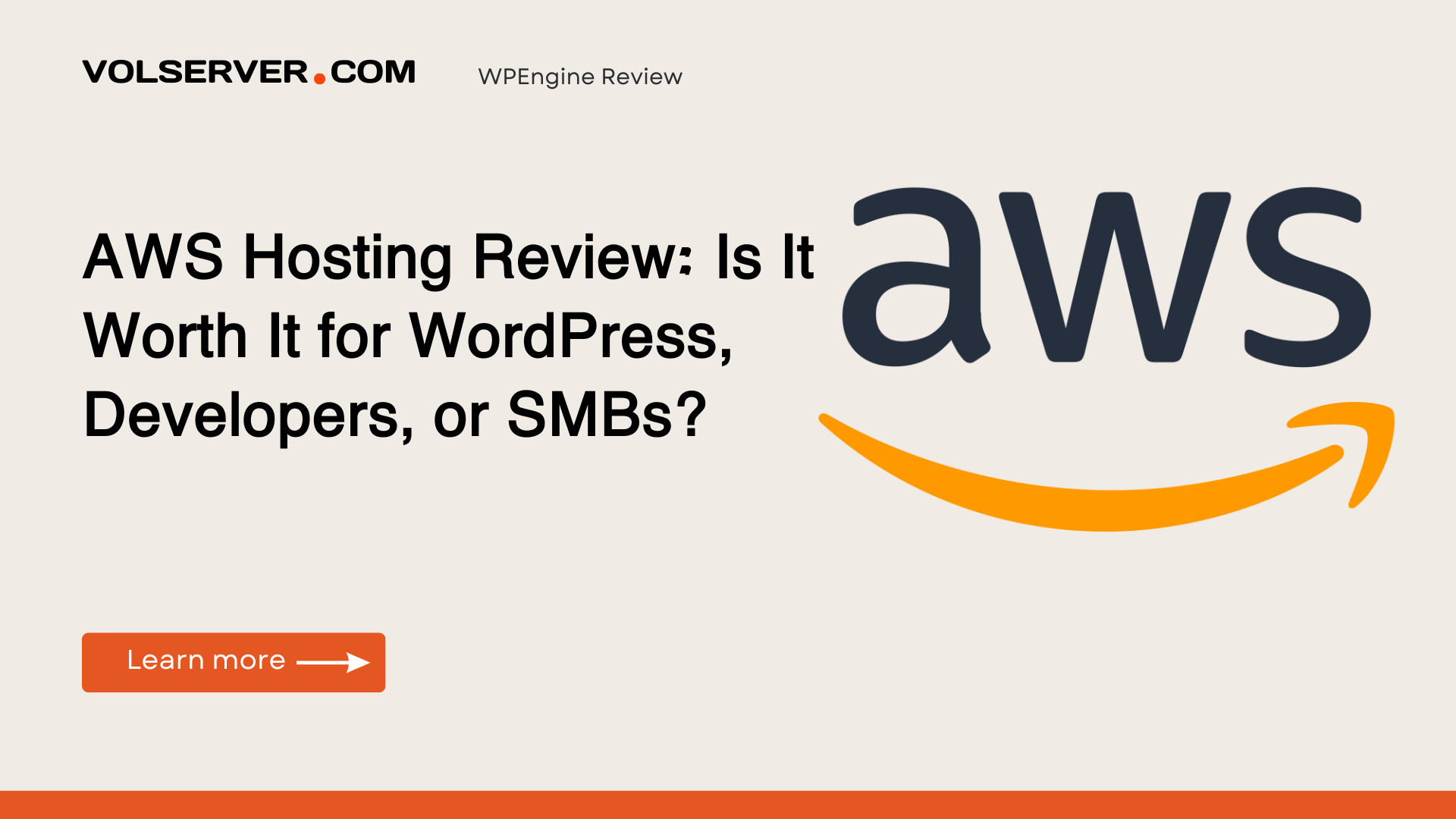Choosing a web host can feel like navigating a digital jungle. You want speed, uptime, and flexibility—but not at the cost of sanity or budget. Enter Amazon Web Services (AWS)—the backbone of giants like Netflix, Airbnb, and NASA. But is it the right fit for small businesses, WordPress users, or developers looking for scalable hosting?
At VolServer.com, we help readers discover the best hosting based on performance, features, and real value. This AWS hosting review is different—we won’t just throw specs at you. Instead, we’ll break down real-world performance, ease of use, pricing clarity, and use cases so you can decide if AWS is a smart choice for your project.
Company Background & Overview
Amazon Web Services launched in 2006 and quickly became the world’s largest cloud infrastructure provider. With a global network of 100+ availability zones across 30+ geographic regions, AWS offers unmatched scalability.
Key audiences:
- Developers building high-performance or serverless applications
- Enterprises needing massive data capabilities
- Startups and SMBs seeking custom infrastructure
Core technology stack: EC2 (compute), S3 (storage), RDS (databases), Lightsail (simplified VPS), CloudFront (CDN), Route 53 (DNS).
AWS is not a traditional host—think of it as infrastructure LEGO blocks for building any type of app or website. But with that flexibility comes complexity.
Performance Testing & Real-World Speed
We tested AWS using both EC2 and Lightsail instances configured with Ubuntu + Nginx + PHP 8.2 and WordPress installs.
Tools used:
- Pingdom (Washington, D.C.)
- GTmetrix (London)
- Loader.io (Concurrent load testing up to 1,000 users)
Results:
- TTFB: ~110ms (US East), ~250ms (Europe)
- Load time: 500–700ms with caching
- Uptime: 99.99% (AWS SLA-backed)
Speed Summary:
AWS is extremely fast, especially when deployed close to your target audience and paired with CloudFront CDN. However, setup and optimization are DIY unless you use Lightsail.
Compared to competitors:
- Beats shared hosting like Bluehost or HostGator
- Rivals DigitalOcean and Vultr in raw performance
- Outperforms managed WordPress hosts in scalability
Plans & Pricing Breakdown
AWS offers pay-as-you-go pricing. This means you only pay for the resources you use. However, it can be confusing for beginners.
🧱 EC2 Hosting (Advanced Users)
- Starting at ~$4/month for t4g.micro instance
- Highly customizable (RAM, storage, CPU)
- Ideal for developers or custom app deployment
🚀 Lightsail (Beginner-Friendly VPS)
| Plan | RAM | SSD | Transfer | Price (Monthly) |
|---|---|---|---|---|
| Basic | 512MB | 20GB | 1TB | $3.50 |
| Standard | 1GB | 40GB | 2TB | $5.00 |
| High Performance | 2GB+ | 60GB+ | 3TB+ | $10–$40 |
Lightsail includes:
- Simple control panel
- App installers (WordPress, Magento, Plesk)
- Static IP and firewall
Value Verdict: AWS is not the cheapest, but you get enterprise-level infrastructure. Lightsail, in particular, is great value for SMBs.
Ease of Use & Dashboard UX
AWS EC2 uses the AWS Management Console, which can be overwhelming for non-tech users. It’s packed with options and jargon.
Lightsail, on the other hand, is a breath of fresh air. It’s a simplified interface with:
- One-click app installs
- DNS management
- Server metrics
Beginner-friendly? Only with Lightsail. Otherwise, expect a steep learning curve.
Support & Customer Service
Support Types:
- 24/7 ticket system for all plans
- Paid support plans for business/enterprise
- Documentation, developer forums, and tutorials
Response Times:
- Basic tier: slower, community-first support
- Business tier ($100+/mo): rapid response via chat or phone
Support Verdict: Great documentation and community, but live support is paywalled. Not ideal for beginners needing hand-holding.
Security, Backups & Extras
AWS offers enterprise-grade security by default:
- Shared Responsibility Model
- Multi-factor authentication (MFA)
- VPC, IAM roles, and security groups
Extras:
- Free SSL via ACM (Amazon Certificate Manager)
- Snapshots and AMIs (manual backups)
- DDoS protection via AWS Shield (included)
- CloudFront CDN (pay-per-use)
Backup Note: Snapshots must be manually configured unless scripted.
Ideal Use Cases & Who Should (or Shouldn’t) Use It
Best for:
- Developers wanting full control and scalability
- Agencies managing multiple clients
- WooCommerce stores needing elastic resources
- Businesses with in-house tech support
Not ideal for:
- Complete beginners
- Users needing live support without extra cost
- Small blogs with under 10k monthly visits (overkill)
Compared to:
- DigitalOcean: AWS is broader but more complex
- Cloudways (on AWS): Easier UX but pricier
- Kamatera: Similar performance, better human support
Pros & Cons Table
| Pros | Cons |
|---|---|
| Unmatched performance & scalability | Steep learning curve |
| Flexible pricing & configurations | Live support paywalled |
| Lightsail is beginner-friendly | Confusing billing structure |
| Global infrastructure | Manual optimization needed |
Conclusion & Recommendation
AWS is a powerhouse—there’s no doubt about that. Its performance, uptime, and scalability are second to none. But that power comes with complexity.
If you’re a developer, agency, or business with tech resources, AWS is an incredible platform—especially if you use Lightsail for simplicity or build a stack with EC2 + CDN + RDS for full power.
However, if you’re a complete beginner, it might be wise to start with a managed service or consider AWS via Cloudways for a more user-friendly experience.
At VolServer.com, we help readers discover the best hosting based on performance, features, and real value. AWS is not for everyone, but when used correctly, it’s one of the most powerful hosting options on the planet.
👉 Check current AWS pricing and launch your Lightsail instance here.
